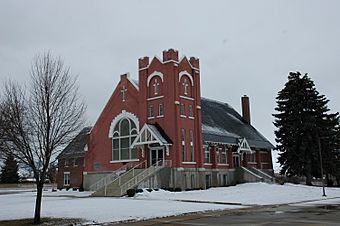Malad Second Ward Tabernacle facts for kids
Quick facts for kids |
|
|
Malad Second Ward Tabernacle
|
|

Eastern (front) and northern sides of the tabernacle
|
|
| Location | 20 S 100 W, Malad City, Oneida County, Idaho |
|---|---|
| Area | >1 acre (>0.405 hectares) |
| Built | 1914–1915 |
| Architect | M. E. Anderson (from Brigham City, Utah) |
| Architectural style | Eclectic, influenced by the bungalow and possibly by the Romanesque Revival, among other things |
| NRHP reference No. | 79000803 |
| Added to NRHP | July 27, 1979 |
The Malad Second Ward Tabernacle is a special building in Malad City, Idaho. It's a place where members of The Church of Jesus Christ of Latter-day Saints meet. This building is important because it's very large and has a unique mix of architectural styles. It also played a big part in the history of Oneida County, which used to be one of the most populated counties in Idaho. This tabernacle is listed on the National Register of Historic Places, along with six other buildings in Oneida County.
Contents
What the Tabernacle Looks Like
Outside the Building
The outside of the tabernacle looks almost the same as when it was first built. The only changes are that the old wooden doors were replaced with metal ones. Also, metal railings were added to the steps at the entrance. Some small repairs were done in 1985.
The building is made of red bricks and has one tall main floor. It has a roof that slopes down on two sides, like a triangle, at the ends. The building sits on a raised basement, which means part of the basement is above ground.
At one corner, there's a square tower with white stone trim. This tower sticks out a bit and holds the main entrance. The front of the building also has a decorative gable, which is the triangular part of the wall under the roof. It's also trimmed with white stone.
A large window in the front is divided into three parts and has beautiful green stained glass. The top of this window is rounded. You can see white stone trim with a stepped design and a special "keystone" shape above this window. This same design is repeated above the entrances and the fan-shaped windows above them. The entrances also have small roofs supported by decorative wooden brackets.
Inside the Building
The inside of the tabernacle is a large open space used for meetings and gatherings. It has a simple, grand design that helps people feel peaceful and focused during services.
History of the Tabernacle
Building a Community Hub
When the Malad Second Ward Tabernacle was built, Malad City was a busy trading center. It connected the Salt Lake Valley in Utah with Butte, Montana. The railroad came to Malad in 1906, and the city's population doubled in the next 15 years.
The tabernacle was designed by M. E. Anderson, an architect from Brigham City, Utah. Many local business people and community members helped pay for the building. Everyone in Malad was excited for the impressive building to be finished. The local newspaper, Idaho Enterprise, often reported on its progress. When it was completed, the tabernacle was surrounded by fields near the train station.
Changes Over Time
The original wooden doors were replaced with metal and glass doors. Metal railings were added to the entry steps, likely around 1949.
On July 27, 1979, the tabernacle was added to the National Register of Historic Places. This was because of its large size, interesting mix of styles, and its importance to the community. At that time, large trees grew around the building, but they are no longer there today.
In 1985, some minor work was done on the building. These changes did not affect its main structure.
Current Use
The building once served as a larger regional meeting place for the Church, called a "stake center." Now, a different building is used for that purpose. The Malad Second Ward Tabernacle currently serves as a regular meetinghouse for three local congregations, known as the Second, Fourth, and Fifth Wards.
See also
- Tabernacle (LDS Church)
- United Presbyterian Church (Malad City, Idaho)
- List of National Historic Landmarks in Idaho
- National Register of Historic Places listings in Oneida County, Idaho
- Oneida County, Idaho



